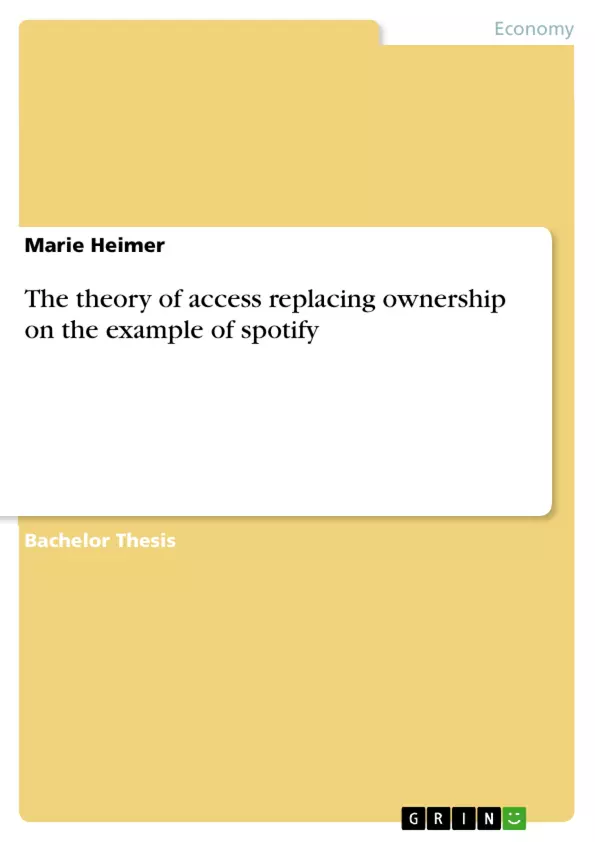Although the recording industry finds itself in a challenging economic situation, very little is known about how to build up a business model which fulfils the demands of a new generation. The theory of access replacing ownership provides another perspective concerning the so-called digital natives. The analysis of the demands of this consumer groups shows that the ownership of music seems to be obsolete to them. The music consumers of today and tomorrow do no longer care about owning music. The Swedish model Spotify offers music on an advertisement and subscription base and is depicted as an example in which consumers are offered a model of access. The thesis results provide general information about the notion of property and ownership as a whole as well as it recovers the development of these notions on the digital age and their deep impact on the economic behaviour and the scope of dealing with these changes.
The thesis uses self generated data from a survey as well as literary sources and serves as a road sign indicating the issues of access in several parts of economy, with the focus on Spotify and the recording industry. The findings of the thesis can be generalised to any industry that offers digital (entertainment) content.
Inhaltsverzeichnis (Table of Contents)
- 1. INTRODUCTION
- 1.1. Introduction
- 1.2. Significance of the research issue
- 1.3. Structure of the thesis
- 2. "HOW IT USED TO BE"
- 2.1. The relevance of ownership and property
- 2.2. The recording industry and its devices
- 3. "HOW IT IS"
- 3.1. Effects of digitalisation on the recording industry
- 3.1.1. Background of digital music
- 3.1.2. Music distribution on the Internet
- 3.2. The digital natives
- 3.2.1. Digital natives and digital immigrants
- 3.2.2. Demands and values of the Net Generation
- 3.2.3. The importance of networking and communities
- 3.2.4. Consuming habits
- 3.3. Spotify
- 3.3.1. Business model
- 3.3.2. Technology & Mobile
- 3.3.3. Features & Community
- 3.3.4. Finance
- 3.3.5. Competitors on the international market
- 3.4. Spotify and its users
- 3.4.1. Depiction of the survey and the samples
- 3.4.2. General usage of the programme
- 3.4.3. Music consumption and ownership
- 3.1. Effects of digitalisation on the recording industry
- 4. "HOW IT WILL BE"
- 4.1. Access replaces ownership
- 4.1.1. The new era of access
- 4.1.2. Shared ownership
- 4.1.3. The rules of the new economy
- 4.2. Spotify and the age of access
- 4.2.1. Music as a public good
- 4.2.2. Spotify as a model of access
- 4.2.3 Music and identity
- 4.1. Access replaces ownership
- 5. PROSPECTS & CONCLUSION
- 5.1. Discussion
- 5.1.1. The Swedish model
- 5.1.2. Aspects of the age of access
- 5.1. Discussion
- The evolving concept of ownership and property in the digital age
- The impact of digitalization on the recording industry
- The characteristics and consumption habits of "digital natives"
- The business model of Spotify and its implications for the future of music consumption
- The emergence of access as a dominant paradigm in the digital economy
- Chapter 1 introduces the research question and outlines the structure of the thesis. It emphasizes the significance of understanding the shift from ownership to access, particularly in the context of the digital music industry.
- Chapter 2 examines the traditional concepts of ownership and property and their relevance to the recording industry. It discusses the historical evolution of the industry and its reliance on physical formats and ownership models.
- Chapter 3 explores the impact of digitalization on the recording industry. It discusses the rise of digital music, the emergence of online distribution platforms, and the characteristics of the "digital natives" who represent the target audience of these platforms. The chapter also provides an in-depth analysis of Spotify, examining its business model, technology, features, financial performance, and competitive landscape.
- Chapter 4 focuses on the notion of access replacing ownership. It explores the new era of access, the concept of shared ownership, and the implications for the digital economy. The chapter discusses how Spotify embodies the principles of access, with music becoming a "public good" rather than a commodity to be owned.
Zielsetzung und Themenschwerpunkte (Objectives and Key Themes)
The thesis examines the shift from ownership to access in the context of the digital music industry, using Spotify as a case study. It investigates the changing demands of "digital natives" and the implications of this shift on the recording industry's business model.
Zusammenfassung der Kapitel (Chapter Summaries)
Schlüsselwörter (Keywords)
The central keywords for this thesis include: digital natives, music industry, ownership, access, digitalization, Spotify, business model, consumer behavior, property, shared ownership, and the digital economy. These terms encapsulate the key concepts and themes explored in the work, highlighting the shift from ownership to access in the context of digital music consumption.
- Citar trabajo
- Marie Heimer (Autor), 2010, The theory of access replacing ownership on the example of spotify, Múnich, GRIN Verlag, https://www.grin.com/document/153699



